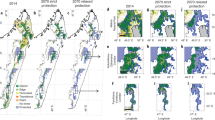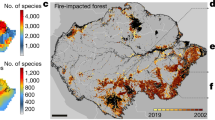Abstract
Estimates of species extinction due to human impact on tropical forests have previously been based on the relationship between species number and area1. Here we use a different approach to estimate loss of tree species in the Atlantic forest of northeast Brazil. We evaluate the characteristics of plant species, their avian dispersers and the distribution of the forest remnants on the landscape to estimate that about 33.9% of tree species in this region will become extinct on a regional scale. Because northeast Brazil is the most threatened sector of South American Atlantic forest2, our results highlight the need to change the current conservation paradigm for this region. Rather than focus on the creation of isolated reserves in any medium-to-large forest remnant, a bioregional planning approach is urgently required to rescue this unique biota from extinction.
This is a preview of subscription content, access via your institution
Access options
Subscribe to this journal
Receive 51 print issues and online access
$199.00 per year
only $3.90 per issue
Buy this article
- Purchase on Springer Link
- Instant access to full article PDF
Prices may be subject to local taxes which are calculated during checkout
Similar content being viewed by others
References
Brooks, T. & Balmford, A. Atlantic forest extinctions. Nature 380, 115 (1996).
Dias, I. S., Câmara, I. G. & Lino, C. F. Workshop Mata Atlântica: Problemas, Diretrizes e Estratégias de Conservação (Fundação SOS Mata Atlântica, São Paulo, 1990).
Müller, P. The Dispersal Centres of Terrestrial Vertebrates in the Neotropical Realm (Junk, The Hague, 1973).
Prance, G. T. in Biological Diversification in the Tropics (ed. Prance, G. T.) 137–158 (Columbia Univ. Press, New York, 1982).
Viana, V. M., Tabanez, A. J. & Batista, J. L. in Tropical Forest Remnants: Ecology, Management, and Conservation of Fragmented Communities (eds Laurence W. F., Laurence, R. O. & Bierregard, J.) 351–365 (Univ. Chicago Press, 1997).
Ranta, P., Blom, T., Niemela, J., Joensuu, E. & Siitonen, M. The fragmented Atlantic rain forest of Brazil: size, shape and distribution of forest fragments. Biodiversity Cons. 7, 385–403 ( 1998).
Almeida, R. T., Pimentel, D. S. & Silva, E. M. S. The Red-handed Howling monkey in the state of Pernambuco, north-east Brazil. Neotropical Primates 3, 174–175 (1995).
Corlett, R. T. & Turner, I. M. in Tropical Forest Remnants: Ecology, Management, and Conservation of Fragmented Communities (eds Laurence, W. F., Laurence, R. O. & Bierregard, J.) 333–346 (Chicago Univ., 1997).
Wunderlee, J. M. The role of animal seed dispersal in accelerating native forest regeneration on degraded tropical lands. Forest Ecol. Managmt. 9 , 223–235 (1997).
Murcia, C. in Forest Patches in Tropical Landscapes (eds. Schellas, J. & Greenberg, R.) 19–36 (Island, Washington DC, 1996).
Laurence, W. F. in Tropical Forest Remnants: Ecology, Management, and Conservation of Fragmented Communities (eds. Laurence, W. F., Laurence, R. O. & Bierregard, J.) 275–280 (Chicago Univ. Press, 1997).
Stotz, D. F., Fitzpatrick, J. W., Parker, T. A. & Moskovits, D. K. Neotropical Birds: Ecology and Conservation (Chicago Univ. Press, 1996).
Guidon, F. C. in Forest Patches in Tropical Landscapes (eds Schellas, J. & Greenberg, R.) 163–186 (Island, Washington DC, 1996).
Galetti, M., Martuscelli, P., Olmos, F. & Aleixo, A. Ecology and conservation of the jucatinga Pipile jacutinga in the Atlantic forest of Brazil. Biol. Cons. 82, 31– 39 (1997).
Moraes, P. L. R. Espécies utilizadas na alimentação no mono-carvoeiro (Brachyteles arachnoides E. Geoffroy, 1806) no Parque Estadual Carlos Botelho. Revista do Instituto Florestal 4, 1206–1208 (1992).
Redford, K. H. The empty forest. BioScience 42, 412– 422 (1992).
Robinson, J. G. in Forest Patches in Tropical Landscapes (eds Schellas, J. & Greenberg, R.) 111–130 (Island, Washington DC, 1996).
Sick, H. Ornitologia Brasileira: uma Introdução (Univ. Brasilia, 1985).
Willis, E. O. The composition of avian communities in remanescent woodlots in southern Brazil. Papéis Avulsos de Zoologia 33, 1 –25 (1979).
Bierregaard, R. O. & Dale, V. H. in Forest Patches in Tropical Landscapes (eds Schelhas, J. & Greenberg, R.) 187–204 (Island, Washington DC, 1996 ).
Silva, J. M. C., Uhl, C. & Murray, G. Plant succession, landscape management, and the ecology of frugivorous birds in abandoned pastures. Cons. Biol. 10, 491 –503 (1996).
Offerman, H. L., Dale, V. H., Pearson, S. M., Bierregaard, R. O. & O'Neill, R. V. Affects of forest fragmentation on neotropical fauna. Environ. Rev. 3, 191 –211 (1995).
Tabarelli, M., Mantovani, W. & Peres, C. A. Effects of habitat fragmentation on plant guil structure in the montane forest of southeastern Brazil. Biol. Cons. 91, 119–127 (1999).
Moermond, T. C. & Denslow, J. S. Neotropical avian frugivores: patterns of behavior, morphology, and nutrition, with consequences for fruit selection. Ornithol. Mon. 36, 865–897 (1985).
Lima, A. R. & Capobianco, J. P. R. Mata Atlântica: avanços legais e institucionais para sua conservação. Documentos do ISA 4, 1–118 ( 1997).
Soulé, M. E. & Terborgh, J. in Continental Conservation: Scientific Foundations of Regional Reserve Network (eds. Soulé, M. E. & Terborgh, J.) 1–17 (Island, Washington DC, 1999).
Caro, T. M. & O'Doherty, G. On the use of surrogate species in conservation biology. Cons. Biol. 13, 805–814.
Pijl, L. Van der Principles of Dispersal of Higher Plants (Springer, Berlin, 1982).
Acknowledgements
We thank the World Wildlife Fund-Brazil and the Conselho Nacional de Desenvolvimento Cientifico e Tecnológico (CNPq) for financial support. The text benefited from comments by V. H. Dale and E. O. Wilson.
Author information
Authors and Affiliations
Corresponding author
Rights and permissions
About this article
Cite this article
da Silva, J., Tabarelli, M. Tree species impoverishment and the future flora of the Atlantic forest of northeast Brazil. Nature 404, 72–74 (2000). https://doi.org/10.1038/35003563
Received:
Accepted:
Issue Date:
DOI: https://doi.org/10.1038/35003563
This article is cited by
-
Genetic diversity and structure in wild Robusta coffee (Coffea canephora A. Froehner) populations in Yangambi (DR Congo) and their relation to forest disturbance
Heredity (2023)
-
White-naped jay, Cyanocorax cyanopogon (Aves, Passeriformes, Corvidae): a potential disperser of diaspores
Ornithology Research (2023)
-
Functional reorganization of dung beetle assemblages in forest-replacing sugarcane plantations
Journal of Insect Conservation (2022)
-
Teamwork: psittacids (Aves, Psittaciformes) disperse and help other birds disperse large diaspores
Ornithology Research (2022)
-
Effects of habitat fragmentation on the demography of the critically endangered tree Pterospermum kingtungense (Sterculiaceae) in Yunnan, China
Tropical Ecology (2021)
Comments
By submitting a comment you agree to abide by our Terms and Community Guidelines. If you find something abusive or that does not comply with our terms or guidelines please flag it as inappropriate.



